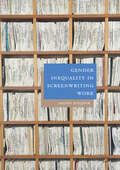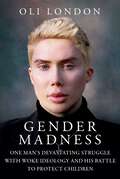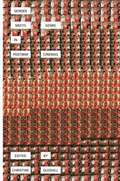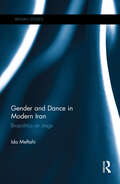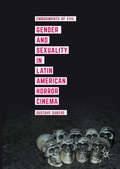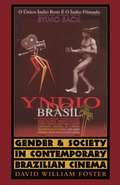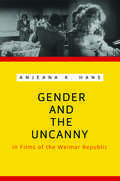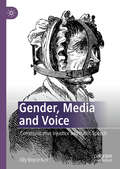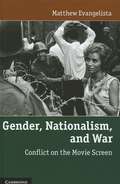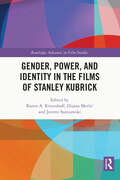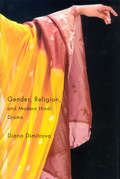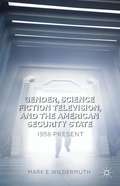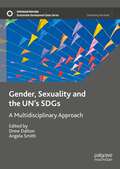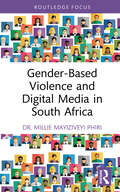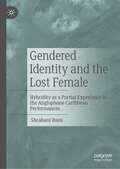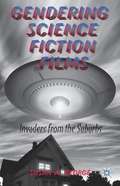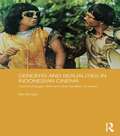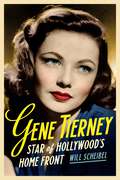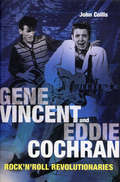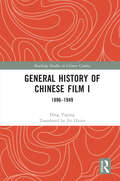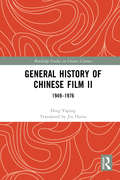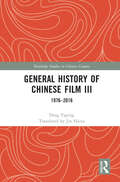- Table View
- List View
Gemini: The Art of Living Well and Finding Happiness According to Your Star Sign
by Sally KirkmanYou are a Gemini. You are the communicator and ideas person of the zodiac.The signs of the zodiac can give us great insight into our day-to-day living as well as the many talents and qualities we possess. But in an increasingly unpredictable world, how can we make sense of them? And what do they mean? This insightful and introductory guide delves deep into your star sign, revealing unique traits and meanings which you didn't know. Along the way, you will discover how your sign defies your compatibility, how to improve your health and what your gifts are. ***The Pocket Astrology series will teach you how to live well and enhance every aspect of your life. From friendship to compatibility, careers to finance, you will discover new elements to your sign and learn about the ancient art of astrology. Other audiobooks in the series include: Aries, Taurus, Gemini, Cancer, Leo, Virgo, Libra, Scorpio, Sagittarius,Capricorn, Aquarius, Pisces(P)2018 Hodder & Stoughton Limited
Gender Inequality in Screenwriting Work
by Natalie WreyfordThis is the first book to critically examine the recruitment and working practices of screenwriters. Drawing on interviews with screenwriters and those that employ them, Natalie Wreyford provides a deep and detailed understanding of entrenched gender inequality in the UK film industry and answers the question: what is preventing women from working as screenwriters? She considers how socialised recruitment and gendered taste result in exclusion, and uncovers subtle forms of sexism that cause women’s stories and voices to be discounted. Gender Inequality in Screenwriting Work also reveals the hidden labour market of the UK film industry, built on personal connections, homophily and the myth of meritocracy. It is essential reading for students and scholars of gender, creative industries, film and cultural studies, as well as anyone who wants to understand why women remain excluded from many key roles in filmmaking.
Gender Madness: One Man's Devastating Struggle with Woke Ideology and His Battle to Protect Children
by Oli LondonHow one man's struggles with self-Identity and detransition lays challenge to the very foundation of the "gender ideology" movement. While documenting his own personal identity struggles with gender and self-identity, British K-Pop singer Oli London explores the root cause of the issue of trans ideology and gender identity, tackling the pressures of social media, the education system, media, and other factors that are pushing a growing number of young people into transitioning. He takes a close look at real world examples and examines laws, research, and data to help lift the lid on the multibillion-dollar gender affirming care industry.Gender Madness gives an intimate look into what led Oli London to want to become a "Korean woman" and how he overcame his battle to become an advocate for the millions of young people who question their own identity. He recently publicly announced he had detransitioned and is living as a male again and has since become an outspoken activist for children and women's rights, appearing regularly on numerous news networks including Fox News, Newsmax, OAN, EWTN, Piers Morgan Uncensored, Tucker Carlson Tonight, and Talk TV to campaign against gender affirming surgery in teenagers. This book shares his deeply personal life journey and his important message to others, all while encouraging readers to question the current societal trends and challenge their own way of thinking.
Gender Meets Genre in Postwar Cinemas
by Christine GledhillThis remarkable collection uses genre as a fresh way to analyze the issues of gender representation in film theory, film production, spectatorship, and the contexts of reception. With a uniquely global perspective, these essays examine the intersection of gender and genre in not only Hollywood films but also in independent, European, Indian, and Hong Kong cinemas. Working in the area of postcolonial cinema, contributors raise issues dealing with indigenous and global cinemas and argue that contemporary genres have shifted considerably as both notions of gender and forms of genre have changed. The volume addresses topics such as the history of feminist approaches to the study of genre in film, issues of female agency in postmodernity, changes taking place in supposedly male-dominated genres, concepts of genre and its use of gender in global cinema, and the relationship between gender and sexuality in film. Contributors are Ira Bhaskar, Steven Cohan, Luke Collins, Pam Cook, Lucy Fischer, Jane Gaines, Christine Gledhill, Derek Kane-Meddock, E. Ann Kaplan, Samiha Matin, Katie Model, E. Deidre Pribram, Vicente Rodriguez Ortega, Adam Segal, Chris Straayer, Yvonne Tasker, Deborah Thomas, and Xiangyang Chen.
Gender and Dance in Modern Iran: Biopolitics on stage (Iranian Studies)
by Ida MeftahiGender and Dance in Modern Iran: Biopolitics on Stage investigates the ways dancing bodies have been providing evidence for competing representations of modernity, urbanism, and religiosity across the twentieth century. Focusing on the transformation of the staged dancing body, its space of performance, and spectatorial cultural ideology, this book traces the dancing body in multiple milieus of performance, including the Pahlavi era’s national artistic scene and the popular café and cabaret stages, as well as the commercial cinematic screen and the post-revolutionary Islamized theatrical stage. It links the socio-political discourses on performance with the staged public dancer, in order to interrogate the formation of dominant categories of "modern," "high," and "artistic," and the subsequent "othering" of cultural realms that were discursively peripheralized from the "national" stage. Through the study of archival and ethnographic research as well as a diverse literature pertaining to music, theater, cinema, and popular culture, it combines a close reading of primary sources such as official documents, press materials, and program notes with visual analysis of filmic materials and imageries, as well as interviews with practitioners. It offers an original and informed exploration into the ways performing bodies and their public have been associated with binary notions of vice and virtue, morality and immorality, commitment and degeneration, chastity and eroticism, and veiled-ness and nakedness. Engaging with a range of methodological and historiographical methods, including postcolonial, performance, and feminist studies, this book is a valuable resource for students and scholars of Middle East history and Iranian studies, as well as gender studies and dance and performance studies.
Gender and Sexuality in Latin American Horror Cinema
by Gustavo SuberoGender and Sexuality in Latin American Horror Cinema explores the different mechanisms and strategies through which horrorfilms attempt to reinforce or contest gender relations and issues of sexualidentity in the continent. The book explores issues of machismo, marianismo,homosociality, bromance, among others through the lens of horror narrativesand, especially, it offers an analysis of monstrosity and the figure of themonster as an outlet to play out socio-sexual anxieties in different societiesor gender groups. The author looks at a wide rage of films from countries suchas Cuba, Peru, Mexico and Argentina and draws points of commonality, as well ascomparing essential differences, between the way that horror fictions -considered by many as low-brow cinema - can be effective to delve into the waythat sexuality and gender operates and circulates in the popular imaginary inthese regions.
Gender and Society in Contemporary Brazilian Cinema
by David William Foster"Gender is an absolute ground zero for most human societies," writes David William Foster, "an absolute horizon of social subjectivity." In this book, he examines gender issues in thirteen Brazilian films made (with one exception) after the 1985 return to constitutional democracy and elimination of censorship to show how these issues arise from and comment on the sociohistorical reality of contemporary Brazilian society.<P><P>Foster organizes his study around three broad themes: construction of masculinity, constructions of feminine and feminist identities, and same-sex positionings and social power. Within his discussions of individual films ranging from Jorge um brasileiro to A hora da estrela to Beijo no asfalto, he offers new ways of understanding national ideals and stereotypes, sexual dissidence (homoeroticism and transgenderism), heroic models, U.S./Brazilian relations, revolutionary struggle, and human rights violations. As the first study of Brazilian cinematic representations of gender ideology in English or Portuguese, this book will be important reading in film and cultural studies.
Gender and the Uncanny in Films of the Weimar Republic (Contemporary Approaches To Film And Media Ser.)
by Anjeana K. HansThe Weimar period in Germany was a time of radical change, when the traditions and social hierarchies of Imperial Germany crumbled, and a young, deeply conflicted republic emerged. Modernity brought changes that reached deep into the most personal aspects of life, including a loosening of gender roles that opened up new freedoms and opportunities to women. The screen vamps, garçonnes, and New Women in this movie-hungry society came to embody the new image of womanhood: sexually liberated, independent, and--at least to some--deeply threatening. In Gender and the Uncanny in Films of the Weimar Republic, author Anjeana K. Hans examines largely forgotten films of Weimar cinema through the lens of their historical moment, contemporary concerns and critiques, and modern film theory to give a nuanced understanding of their significance and their complex interplay between gender, subjectivity, and cinema. Hans focuses on so-called uncanny films, in which terror lies just under the surface and the emancipated female body becomes the embodiment of a threat repressed. In six chapters she provides a detailed analysis of each film and traces how filmmakers simultaneously celebrate and punish the transgressive women that populate them. Films discussed include The Eyes of the Mummy (Die Augen der Mumie Mâ, Ernst Lubitsch, 1918), Uncanny Tales (Unheimliche Geschichten, Richard Oswald, 1919), Warning Shadows (Schatten: Eine nächtliche Halluzination, Artur Robison, 1923), The Hands of Orlac (Orlacs Hände, Robert Wiene, 1924), A Daughter of Destiny (Alraune, Henrik Galeen,1928), and Daughter of Evil (Alraune, Richard Oswald, 1930). An introduction contextualizes Weimar cinema within its unique and volatile social setting. Hans demonstrates that Weimar Germany's conflicting emotions, hopes, and fears played out in that most modern of media, the cinema. Scholars of film and German history will appreciate the intriguing study of Gender and the Uncanny in Films of the Weimar Republic.
Gender, Cinema, Streaming Platforms: Shifting Frames in Neoliberal India
by Šarūnas Paunksnis Runa Chakraborty PaunksnisThis book offers interdisciplinary examination of gender representations in cinema and SVOD (Subscription Video on Demand) platforms in India. This book will identify how the so-called feminist enunciations in twenty-first century film and SVOD content in India are marked by an ambiguous entanglement of feminist and postfeminist rhetoric. Set against the backdrop of two significant contemporary phenomena, namely neoliberalism and the digital revolution, this book considers how neoliberalism, aided by technological advancement, re-configured the process of media consumption in contemporary India and how representation of gender is fraught with multiple contesting trajectories. The book looks at two types of media—cinema and SVOD platforms, and explores the reasons for this transformation that has been emerging in India over the past two decades. Keeping in mind the complex paradoxes that such concomitant process of the contraries can invoke, the book invites myriad responses from the authors who view the shifting gender representations in postmillennial Hindi cinema and SVOD platforms from their specific ideological standpoints. The book includes a wide array of genres, from commercial Hindi films to SVOD content and documentary films, and aims to record the transformation facilitated by economic as well as technological revolutions in contemporary India across various media formats.
Gender, Media and Voice: Communicative Injustice and Public Speech
by Jilly Boyce KayThis book explores the increasing imperatives to speak up, to speak out, and to ‘find one’s voice’ in contemporary media culture. It considers how, for women in particular, this seems to constitute a radical break with the historical idealization of silence and demureness. However, the author argues that there is a growing and pernicious gap between the seductive promise of voice, and voice as it actually exists. While brutal instruments such as the ducking stool and scold’s bridle are no longer in use to punish women’s speech, Kay proposes that communicative injustice now operates in much more insidious ways. The wide-ranging chapters explore the mediated ‘voices’ of women such as Monica Lewinsky, Hannah Gadsby, Diane Abbott, and Yassmin Abdel-Magied, as well as the problems and possibilities of gossip, nagging, and the ‘traumatised voice’ in television talk shows. It critiques the optimistic claims about the ‘unleashing’ of women’s voices post-#MeToo and examines the ways that women’s speech continues to be trivialized and devalued. Communicative justice, the author argues, is not about empowering individuals to ‘find their voice’, but about collectively transforming the whole communicative terrain.
Gender, Nationalism, and War
by Matthew EvangelistaVirginia Woolf famously wrote 'as a woman I have no country', suggesting that women had little stake in defending countries where they are considered second-class citizens, and should instead be forces for peace. Yet women have been perpetrators as well as victims of violence in nationalist conflicts. This unique book generates insights into the role of gender in nationalist violence by examining feature films from a range of conflict zones. In The Battle of Algiers, female bombers destroy civilians while men dress in women's clothes to prevent the French army from capturing and torturing them. Prisoner of the Mountains shows a Chechen girl falling in love with her Russian captive as his mother tries to rescue him. Providing historical and political context to these and other films, Matthew Evangelista identifies the key role that economic decline plays in threatening masculine identity and provoking the misogynistic violence that often accompanies nationalist wars.
Gender, Power, and Identity in The Films of Stanley Kubrick (Routledge Advances in Film Studies)
by Jeremi Szaniawski Karen A. Ritzenhoff Dijana MetlićThis volume features a set of thought-provoking and long overdue approaches to situating Stanley Kubrick’s films in contemporary debates around gender, race, and age – with a focus on women’s representations. Offering new historical and critical perspectives on Kubrick’s cinema, the book asks how his work should be viewed bearing in mind issues of gender equality, sexual harassment, and abuse. The authors tackle issues such as Kubrick’s at times questionable relationships with his actresses and former wives, the dynamics of power, misogyny and miscegenation in his films, and auteur ‘apologism’, among others. The selection delineates these complex contours of Kubrick’s work by drawing on archival sources, engaging in close readings of specific films, and exploring Kubrick through unorthodox venture points. With an interdisciplinary scope and social justice-centered focus, this book offers new perspectives on a well-established area of study. It will appeal to scholars and upper-level students of film studies, media studies, gender studies, and visual culture, as well as to fans of the director interested in revisiting his work with a new perspective.
Gender, Religion, and Modern Hindi Drama
by Diana DimitrovaDiana Dimitrova studies the representation of gender and religion in Hindi drama from its beginnings in the second half of the nineteenth century until the 1960s - the period when urban proscenium Hindi theatre, which originated under Western influence, matured and thrived. Her focus is on how different religious and mythological models pertaining to women have been reworked in Hindi drama and whether the seven representative dramatists discussed in this book present conservative or liberating Hindu images of the feminine. She examines how the intersections of gender, religion, and ideology account for the creation of the canon of modern Hindi drama, specifically the assertion of a conservative interpretation of orthodox Hindu images of the feminine as well as the exclusion of dramatists who introduce innovative liberating images of the feminine. The overt reason for the negative attitude toward this innovative representation of gender is that it is perceived as "Western" and thus "non-Indian." By contrast, the author's analysis of Hindu mythology, religion, and theatre history reveals that the new interpretation of gender is deeply embedded in Hindu tradition and is thus both Hindu Indian and modernist Western in character.
Gender, Religion, and Modern Hindi Drama
by Diana DimitrovaDiana Dimitrova studies the representation of gender and religion in Hindi drama from its beginnings in the second half of the nineteenth century until the 1960s - the period when urban proscenium Hindi theatre, which originated under Western influence, matured and thrived. Her focus is on how different religious and mythological models pertaining to women have been reworked in Hindi drama and whether the seven representative dramatists discussed in this book present conservative or liberating Hindu images of the feminine. She examines how the intersections of gender, religion, and ideology account for the creation of the canon of modern Hindi drama, specifically the assertion of a conservative interpretation of orthodox Hindu images of the feminine as well as the exclusion of dramatists who introduce innovative liberating images of the feminine. The overt reason for the negative attitude toward this innovative representation of gender is that it is perceived as "Western" and thus "non-Indian." By contrast, the author's analysis of Hindu mythology, religion, and theatre history reveals that the new interpretation of gender is deeply embedded in Hindu tradition and is thus both Hindu Indian and modernist Western in character.
Gender, Science Fiction Television, And The American Security State
by Mark E. WildermuthAs American security became increasingly dependent on technology to shape the consciousness of its populace and to defend them, science fiction shows like The Twilight Zone, Star Trek, and The X-Files both promoted the regime's gendered logic and raised significant questions about that logic and its gendered roles.
Gender, Sexuality and the UN's SDGs: A Multidisciplinary Approach (Sustainable Development Goals Series)
by Angela Smith Drew DaltonAgainst the backdrop of Covid-19, this edited volume will utilize a gendered lens to explore the United Nation’s Sustainable Development Goals (SDGs), with a clear focus on challenging the omission of sexuality in relation to the SDGs as well as analyzing the ways in which the SDGs are also equally relevant for Western countries. While acknowledging the importance of these goals, contributors unpack the exclusion of marginalized genders and sexualities as well as how popular media and social media contribute to the wider understanding of issues of gender and sexuality and the SDGs. This volume also dispels assumptions about the irrelevance of SDGs to countries in the West, with a particular focus on the UK. Chapters examine a variety of topics including: HIV/AIDS, sex work, global migration, climate change and environmental sustainability, poverty, education, and sexual harassment. This collection will be of interest to scholars, researchers, and students across Sociology, Gender & Sexuality Studies, Education, Development Studies and Sustainability Studies.
Gender-Based Violence and Digital Media in South Africa (Routledge Focus on Media and Cultural Studies)
by Millie Mayiziveyi PhiriThis book presents a new paradigm for attending to gender-based violence (GBV) social media discourse among marginalised Black women in South Africa. Focusing on the intersections of television and social media, the study charts the morphing and merging of the “inside” of the soap opera and the “outside” of the real world, amid a rise in feminist social media activism. The analysis begins with coverage of gender-based violence in a long-running South African soap opera and social media discussion of these issues, in parallel with real-world events and the collective social media response. The author offers pertinent insights into audiences in sub-Saharan Africa, presenting a new feminist trajectory for women and activism in the region. Offering new insights into an important issue, this book will be of interest to scholars and students of gender, cultural studies, film studies, television studies, sociology, development studies, feminism, media, and journalism.
Gendered Identity and the Lost Female: Hybridity as a Partial Experience in the Anglophone Caribbean Performances
by Shrabani BasuThis book offers an exploration of the postcolonial hybrid experience in anglophone Caribbean plays and performance from a feminist perspective.In a hitherto unattempted consideration of Caribbean theatre and performance, this study of gendered identities chronicles the postcolonial hybrid experience – and how it varies in the context of questions of sex, performance and social designation. In the process, it examines the diverse performances of the anglophone Caribbean. The work includes works by Caribbean anglophone playwrights like Derek Walcott, Mustapha Matura, Michael Gikes, Dennis Scott, Trevor Rhone, Earl Lovelace and Errol John with more recent works of Pat Cumper, Rawle Gibbons and Tony Hall. The study would also engage with Carnival, calypso and chutney music, while commenting on its evolving influences over the hybrid imagination.Each section covers the dominant socio-political thematics associated with the tradition and its effect on it, followed by an analysis of contemporaneously significant literary and cultural works – plays, carnival narrative and calypso and chutney lyrics as well as the experiences of performers. From Lovelace’s fictional Jestina to the real-life Drupatee, the book critically explores the marginalization of female performances while forming a hybrid identity.
Gendering Science Fiction Films
by Susan A. GeorgeIn the 1950s, science fiction (SF) invasion films played a complicated part in both supporting and criticizing Cold War ideologies. George examines what these films reveal about the tensions in the United States at the dawn of the atomic age especially concerning gender roles and expectations. Using a cultural studies approach, she works from the assumption that "invasion" films with their "us" versus "them" nature provide important visual and verbal narratives for American citizens' trying to understand and negotiate the social and political changes that followed the allied victory in World War II. By reading these invasion narratives as performances of middle-class, primarily white Americans' excitement and anxieties about social and political issues, George shows how they often played out as another round in the battle of the sexes. This book examines the way representation in these films tap into anxieties concerning the feminine and alien other.
Genders and Sexualities in Indonesian Cinema: Constructing gay, lesbi and waria identities on screen (Media, Culture and Social Change in Asia)
by Ben MurtaghIndonesia has a long and rich tradition of homosexual and transgender cultures, and the past 40 years in particular has seen an increased visibility of sexual minorities in the country, which has been reflected through film and popular culture. This book examines how representations of gay, lesbian and transgender individuals and communities have developed in Indonesian cinema during this period. The book first explores Indonesian engagement with waria (male-to-female transgender) identities and the emerging representation of gay and lesbi Indonesians during Suharto’s New Order regime (1966-98), before going on to the reimagining of these positions following the fall of the New Order, a period which saw the rebirth of the film industry with a new generation of directors, producers and actors. Using original interview research and focus groups with gay, lesbi and waria identified Indonesians, alongside the films themselves and a wealth of archival sources, the book contrasts the ways in which transgendered lives are actually lived with their representations on screen.
Gene Tierney: Star of Hollywood's Home Front (Contemporary Approaches to Film and Media Series)
by Will ScheibelGene Tierney may be one of the most recognizable faces of studio-era Hollywood: she starred in numerous classics, including Leave Her to Heaven, The Ghost and Mrs. Muir, and Laura, with the latter featuring her most iconic role. While Tierney was considered one of the most beautiful women in Hollywood, she personified "ordinariness" both on- and off-screen. Tierney portrayed roles such as a pinup type, a wartime worker, a wife, a mother, and, finally, a psychiatric patient—the last of which may have hit close to home for her, as she would soon leave Hollywood to pursue treatment for mental illness and later attempted suicide in the 1950s. After her release from psychiatric clinics, Tierney sought a comeback as one of the first stars whose treatment for mental illness became public knowledge. In this book, Will Scheibel not only examines her promotion, publicity, and reception as a star but also offers an alternative history of the United States wartime efforts demonstrated through the arc of Tierney’s career as a star working on the home front. Scheibel’s analysis aims to showcase that Tierney was more than just "the most beautiful woman in movie history," as stated by the head of production at Twentieth Century Fox in the 1940s and 1950s. He does this through an examination of her making, unmaking, and remaking at Twentieth Century Fox, rediscovering what she means as a movie legend both in past and up to the present. Film studies scholars, film students, and those interested in Hollywood history and the legacy of Gene Tierney will be delighted by this read.
Gene Vincent & Eddie Cochran
by John CollisThe United Kingdom had never seen anything like it, as two rock'n'roll legends rampaged around the country on Britain's first-ever rock tour. Gene Vincent and Eddie Cochran lived the rock'n'roll lifestyle to the full, bringing to an end the monochrome 1950s and ushering in the swinging 60s.John Collis has traced the story of the UK tour that was a defining moment in British popular culture to its tragic climax with the death of Eddie Cochran. He looks back on the contrasting backgrounds of the two stars, follows the tale onwards to Gene Vincent's death from alcohol and drug abuse, and examines the lasting legacy of their music.
General History of Chinese Film I: 1896–1949 (Routledge Studies in Chinese Cinema)
by Ding YapingThe early years of the history of Chinese film have lately been the subject of resurgent interest and a growing body of scholarship has come to recognise and identify an extraordinarily diverse and complex period. This volume explores the development of Chinese film from 1896 to 1949. The volume covers the screening of foreign films in Shanghai, Hong Kong and other coastal cities in China, the technological and industrial development of Chinese national cinema, key filmmakers and actors of early Chinese cinema, changing modes of representation and narration, as well as the social and cultural contexts within which early Chinese films were produced and circulated. The relationship between the War of Resistance against Japan and the Chinese civil war and Chinese film is also explored. The book will be essential reading for scholars and students in film studies, Chinese studies, cultural studies and media studies, helping readers develop a comprehensive understanding of Chinese film.
General History of Chinese Film II: 1949-1976 (Routledge Studies in Chinese Cinema)
by Ding YapingSince 1949, Chinese film has been greatly influenced by a variety of historical, cultural, and political events in the history of the People’s Republic of China. This volume explores the development of Chinese film from 1949 to 1976. This volume restores Chinese film to its original historical form and assesses its complex relationship with society, politics, culture, and art in the Maoist period. The 17-year films, Cultural Revolution-era films, the influence of model operas, and the documentary newsreels of Xinwen Jianbao are discussed. Combining a macro-perspective with a micro-perspective, the author analyzes the special characteristics of Chinese film in this period and showcases the inheritance and differences between earlier Chinese film and Chinese film in the newly founded the People’s Republic of China. The book will be essential reading for scholars and students in film studies, Chinese studies, cultural studies, and media studies, helping readers develop a comprehensive understanding of Chinese film.
General History of Chinese Film III: 1976–2016 (Routledge Studies in Chinese Cinema)
by Ding YapingThe Reform and Opening-up of China since the late 1970s has not only transformed the economic and political situation of the country, but also transformed the Chinese film industry. This volume focuses on the 40 years of the history of Chinese film in the post-Mao era. As all aspects of film production, distribution and exhibition have been commercialized, Chinese film has become an industry of immense scale and has grown by leaps and bounds. Meanwhile, contemporary Chinese film is marked by a new zeitgeist, with Chinese film closely integrated with Chinese society and the economy. The author argues that the Chinese film industry clearly stands at a turning point where the future of Chinese film and the way to further awaken, change, and shape film production have become important issues worth consideration in contemporary film history. The book will be essential reading for scholars and students in film studies, Chinese studies, cultural studies and media studies, helping readers develop a comprehensive understanding of Chinese film.

